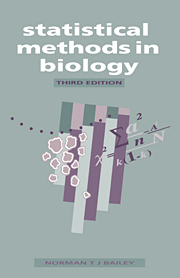Book contents
- Frontmatter
- Contents
- Preface
- 1 Introduction
- 2 Variability and frequency distributions
- 3 Estimation, standard errors and confidence limits
- 4 The basic idea of a significance test
- 5 Simple significance tests based on the normal distribution
- 6 The use of t-tests for small samples
- 7 Contingency tables and χ2
- 8 χ2-tests of goodness-of-fit and homogeneity
- 9 The correlation of measurements
- 10 Regression analysis
- 11 Simple experimental design and the analysis of variance
- 12 Introduction to factorial experiments
- 13 Random samples and random numbers
- 14 Partial correlation and multiple regression
- 15 Non-parametric and distribution-free tests
- 16 Notes on numerical calculation, calculators and computers
- Suggestions for more advanced reading
- Summary of statistical formulae
- Appendix tables
- Index
9 - The correlation of measurements
Published online by Cambridge University Press: 05 June 2012
- Frontmatter
- Contents
- Preface
- 1 Introduction
- 2 Variability and frequency distributions
- 3 Estimation, standard errors and confidence limits
- 4 The basic idea of a significance test
- 5 Simple significance tests based on the normal distribution
- 6 The use of t-tests for small samples
- 7 Contingency tables and χ2
- 8 χ2-tests of goodness-of-fit and homogeneity
- 9 The correlation of measurements
- 10 Regression analysis
- 11 Simple experimental design and the analysis of variance
- 12 Introduction to factorial experiments
- 13 Random samples and random numbers
- 14 Partial correlation and multiple regression
- 15 Non-parametric and distribution-free tests
- 16 Notes on numerical calculation, calculators and computers
- Suggestions for more advanced reading
- Summary of statistical formulae
- Appendix tables
- Index
Summary
THE GENERAL NOTION OF CORRELATION
A great many important numerical investigations are concerned with the association between two different kinds of measurement or classification. Several examples were given in Chapter 7 in connection with the use of contingency tables. These were primarily introduced to deal with a two-way classification of qualitative characters such as hair colour or eye colour, but could be applied to continuous variables if these were suitably grouped. Although indices such as the mean square contingency can be employed to measure the strength of the association present, as opposed to the use of χ2 for a significance test, they are not ideal in situations where both characters show continuous variation of a kind that frequently arises in practice.
Consider, for example, the data in Table 14 in the next section, relating to the stature of fathers and sons. Each unit of observation is a father–son pair, and we can label the first measurement x and the second y. The table shows how a particular sample of family pairs was actually distributed. It is interesting to note that, as we should expect, tall fathers tend to have tall sons, and short fathers tend to have short sons. The association is by no means complete, although there is a preponderance of entries in the top left-hand and the bottom right-hand parts of the table. If the association were complete or nearly so, we should expect the entries to be concentrated along a diagonal set of cells.
Information
- Type
- Chapter
- Information
- Statistical Methods in Biology , pp. 89 - 103Publisher: Cambridge University PressPrint publication year: 1995
